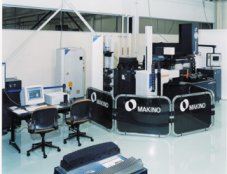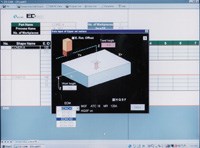Offline Programming for Competitive Solutions
New EDM technology can improve cycle time reduction and enhance cost savings.
Share
There are two issues with EDM operations in the U.S. that hamper production and cost efficiency. One is a growing need for experienced EDM operators, who are in critical shortage. The other is the subsequent lack of offline programming solutions software to help alleviate this problem in order to meet the increasing demand for production volume.
American job shops are located in the middle of the world's biggest marketplace. Customers simply will not be able to send their outsourced work overseas if speed in delivery is provided here that offsets any lower labor cost savings they can gain in Asia.
As customers begin to explore options for maximizing their manpower and machinery investment, software programs are in development to help stabilize EDM processes and procedures through offline management. And the more options customers have for their investment in machine technology, the better off and more profitable they will be. Such advancements will negate both of these issues and help make EDM technology competitive with advancements in direct milling. Milling is often faster than EDM, and may be the better solution for certain applications. But many plastic injection moldmakers may need small diameters and holes, complex shapes and tight details that cannot be milled. As the old saying goes, "Milling cannot make a square hole."
Combination efforts of EDM offline programming and milling may prove to be most beneficial in modern environments. These operations can quickly mill what they can and EDM the detail while adjusting to machine and manpower availability.
Why Program EDM Offline?
This new software enhances sinker or ram EDM capabilities through the direct reception and proper calibration of workpiece data as a critical relay between the machines and CAD/CAM systems. It receives all of the necessary peripheral information from the CAM systems - such as electrode positioning - and adds the necessary burning technology and tool change data to output a final numerical controlled (NC) program for the EDM machine to utilize.
This removal of manual data input processes eliminates many problems and errors that often occur in this type of transfer, and can reduce the mold price material ratio by 30 to 40 percent. Offline programming software is intended for minimal operator input. Operators then can spend less time on verifying directions and more time being productive in their craft.
Corrections then can be adjusted or made before the burn is started - and before costly metals billets are wasted - while eliminating time and maintaining productivity. This should subsequently lead to less scrap and scrapped mold components, and should help increase machine shop efficiency in order to drive out operational costs.
Reducing Errors, Cost and Time
Operator errors happen and mistakes are made when an inaccurate number or misplaced decimal point is entered into a burn program and a cavity detail is scrapped. With this new software, the information is received directly from the part drawing or CAD/CAM system and dumped into the burn program without any human intervention.
This essentially provides machine shops full offline programming capabilities, making CAD/CAM departments more versatile and operators more efficient. The new software technology will allow mold/die shops to use machines more cost effectively, drive out operational costs, reduce leadtime and quicken product time-to-market. In addition, it offers shops a distinct edge over the competitors who are capable of making the same molds at the same tolerances.
Offline Software Operation
Offline software such as this will input position points from a design system directly into a burn program. In addition to translating positioning data, the software will help operators determine critical burn parameters, such as electrode material and quantity, undersize parameters, desired removal rates and surface finishes. This technological advancement creates burn parameters that in the past could only be determined by an operator with several years of experience.
For example, an operator typically uses the EDM machine to complete a job before using the same machine to load all of the electrodes and workpieces required for the next burn. This process ties up valuable machine resources and increases cycle time. With this software, an operator can pick up electrode offsets and workpieces offline on a coordinate measuring machine and have the data transferred to the program for use.
In addition, an operator can start a burn program on a machine and then prepare future burns on a remote computer and send them directly to the machine. All that is required then is an operator to push the start button.
A software package like this allows shops to plan ahead for the next job while one is being done and manipulates the data in a much more efficient flow. This technological improvement helps companies out-produce their competitors because of the advantage they gain for their customers in reduced leadtime and cycle time.
Because the software takes control of the programming process, a highly skilled applications engineer or moldmaker is not required to run the EDM machine. However, operators who have little or no training on an EDM machine can develop burn programs using offline programming solutions software, which will actually help bring them up to a more experienced level of application knowledge.
Unmanned Operations
Offline software systems for EDM production, teamed with other software for advanced automation, requires machines with high rigidity for the best accuracy and performance. Multi-directional burning with identical servo performance, a disappearing drop tank, complex orbit control, interactive automatic programming and an adaptive control system that reduces or eliminates active flushing are critical elements to EDM automation.
Unmanned operations create the optimum system for small-lot, large variety production, which readily accommodates production change priorities. It also helps maintain efficient throughput, utilizing less floor space and allowing the timely transfer of jobs to the next process.
Offline programming solutions will save future operation costs, but in the vein of labor realignment, not labor replacement. The investment in such a system will be smaller - by as much as about 18 percent. And, labor costs may decrease by about 30 percent.
But, this doesn't mean that you replace your labor with offline solutions. Skilled craftsmen are too valuable to the machine tool industry. What it will do is allow you to better utilize your valuable human resources in a more productive and flexible fashion.
For example, the manufacturing process may become more streamlined and efficient. Some jobs will still have to be done by the experienced and skilled professional. But time-consuming operations like job setup, alignment, positioning, programming, removal and cleanup can all be eliminated. These activities are non-productive, inappropriate and inefficient use of a master toolmaker.
And, job in/job out processes will allow work to be removed from multiple setups while other aspects are still being completed. Oftentimes in multiple setups, the speed of the manufacturing process on all parts is at the mercy of the one that takes the longest to manufacture.
Automating the Future
Moldmaking is changing, and software needs to change with machine technology to lead that effort. In the future, such offline programming solutions technology may help support or lead to such advancements as complete robotic automation systems. This proves best for applications such as machining small and intricate components that lend themselves to short cycle times. These processes include coreless machining routines, lead frame electronic molds and dies, connector molds, small dies and bushings and small- to medium-sized multi-cavity molds of at least four cavities.
A fully automated EDM system with work and electrode changing can increase shop capacity by 650 percent compared to manual EDM and tooling processes, according to data provided by EROWA Technologies (Arlington Heights, IL). A capacity of 800 hours can be increased to 6,000 hours using full automation.
There is no best way to make a mold. The job shape has to determine manpower and machinery availability, costs, time, process and procedure, quality and technology. Mass production of similar dies and molds is minimal, as most every job in the die mold industry is special made.
Larger work with longer cycle times and secondary operations may be handled better by automation than stand-alone machinery. Work that is highly repetitive and that lends itself to inserts and standardization also will benefit, such as electronic connector tooling, caps and closures, and medical molds.
To support automation and to stay competitive, all options for technological investment need to be investigated, including offline programming solutions. Thanks to the immediate advantages of this type of software, moldmakers look forward to a future of efficient operations, lower costs and, thankfully, less scrap. It could even further enhance shop versatility and flexibility.
Related Content
Solving Mold Alignment Problems with the Right Alignment Lock
Correct alignment lock selection can reduce maintenance costs and molding downtime, as well as increase part quality over the mold’s entire life.
Read MoreFundamentals of Designing the Optimal Cooling System
The right mold components can help improve mold cooling and thereby produce higher-quality parts.
Read MoreRevisiting Some Hot Runner Fundamentals
What exactly does a hot runner do? If you’ve been in the injection molding industry for any length of time, you might think the answer is obvious, but it is not.
Read MoreLaser Welding Versus Micro Welding
The latest battle in finely detailed restoration/repair of mold materials.
Read MoreRead Next
How to Use Continuing Education to Remain Competitive in Moldmaking
Continued training helps moldmakers make tooling decisions and properly use the latest cutting tool to efficiently machine high-quality molds.
Read MoreAre You a Moldmaker Considering 3D Printing? Consider the 3D Printing Workshop at NPE2024
Presentations will cover 3D printing for mold tooling, material innovation, product development, bridge production and full-scale, high-volume additive manufacturing.
Read MoreHow to Use Strategic Planning Tools, Data to Manage the Human Side of Business
Q&A with Marion Wells, MMT EAB member and founder of Human Asset Management.
Read More























